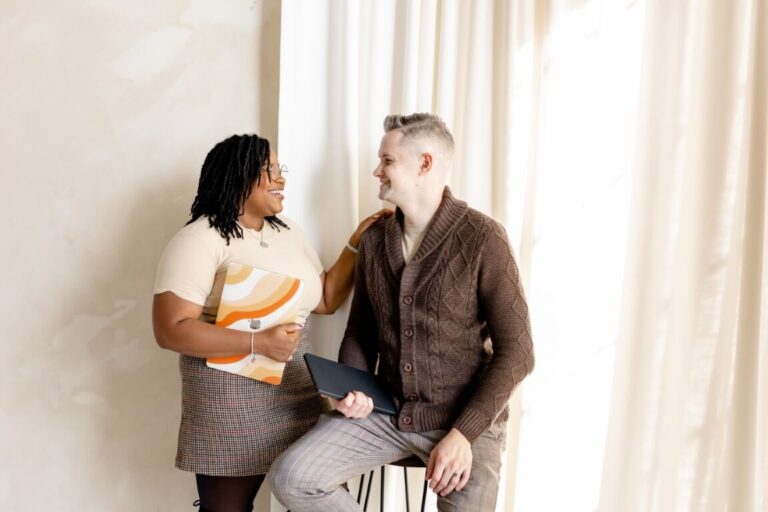The Art of Illustration in Graphic Design
Have you ever wondered how illustrators create captivating designs that grab your attention and convey a message? Illustration plays a crucial role in graphic design, as it can communicate complex concepts and ideas while adding an aesthetic appeal to the overall design. In today’s fast-paced digital world, designers use many different styles of illustration to create unique and eye-catching designs.
Understanding Different Illustration Styles
Illustrations are created using different techniques and styles. Traditional illustration styles like watercolour, pen and ink, or charcoal have been around for centuries and continue to be popular today. Digital illustration styles such as vector art, pixel art, or 3D graphics have emerged with technological advances.
Mixed-media illustrations also combine traditional techniques with digital ones for unique looks. Lesser-known niche styles like woodcut, engraving or stippling offer designers even more options when creating artwork.
Importance of Understanding Different Styles for Designers
Illustration is an effective way to communicate complex ideas quickly and effectively through visual cues. Understanding the different illustration styles available can help designers create designs that convey messages accurately while staying true to their brand’s identity.
Moreover, understanding the different illustration techniques can allow designers to experiment with various visual elements during the design process. Knowing what style works best for a particular project is essential – a traditional watercolour style may not be appropriate for a modern tech start-up’s logo design. In contrast, hand-drawn illustrations could work well for a children’s book cover page but may not suit a corporate annual report’s theme.
Mastering the art of illustrating is crucial if you’re looking forward to becoming an excellent graphic designer. Having knowledge about various illustrating methods and techniques and understanding your client’s requirements can help you create compelling designs that stand out from the crowd.
Traditional Illustration Styles
When we think of traditional illustration styles, we often think of watercolour, pen and ink, and charcoal. These are the types of illustrations that have been around for centuries and are still highly regarded in the art world today.
Each style has its unique look and feel, making it essential for designers to understand their differences. Watercolour illustrations are known for their softness and fluidity.
They’re created by adding layers of transparent colours to create different shades and textures. Watercolours can create airy landscapes or whimsical characters with a touch of beautiful imperfection.
Pen and ink illustrations, on the other hand, are more precise and detailed. They’re created using a nib pen or brush dipped in ink to create various line weights and textures.
This style is perfect for creating intricate designs or realistic portraits. Charcoal illustrations have a raw, expressive quality that distinguishes them from other traditional techniques.
They’re created by smudging charcoal onto paper with your fingers or a stump tool to create shades of gray. Charcoal is excellent for creating dramatic shadows or sketches that instantly capture movement.
Traditional illustration styles can be found in many graphic design projects, from book covers to packaging designs. For example, watercolour illustrations are often used in greeting card designs or as backgrounds on websites, while pen and ink illustrations work well on posters or editorial layouts.
Charcoal illustrations work great as part of branding materials such as business cards or logos where you want to convey an edgier vibe. Whether you’re working with clients who love traditional illustration styles or want to add vintage flair to your graphic design projects, understanding these styles can help you produce stunning results that will capture attention immediately!
Digital Illustration Styles
In today’s digital age, it’s no surprise that many graphic designers turn to digital illustration styles to create their designs. Digital illustration offers a range of techniques that are impossible to replicate with traditional tools. Here are just a few examples of popular digital illustration styles:
Vector Illustrations
Vector illustrations use mathematical equations to create lines and shapes. This style is perfect for creating clean, simple designs with sharp edges and bold colours. Vector illustrations can easily be resized without losing quality, making them ideal for logos, icons, and other designs that must be adapted for various sizes.
The iconic Apple logo is a perfect example of vector illustrations in graphic design. The simple apple design with a bite taken out lends itself to being made into vector format because it relies on simple shapes and lines.
Pixel Art
Pixel art is a retro-style digital illustration technique that uses small squares or pixels to create an image. This style became popular in video games in the 1980s and 90s but has recently made a comeback as designers look for unique ways to stand out. Pixel art requires precision and patience, as each pixel must be placed deliberately.
Despite its seemingly limited nature due to its blockiness, pixel art can convey complex emotions. One great example of pixel art in graphic design is the cover art for the game “Undertale.” The game uses pixel art throughout its design, including its memorable characters,, all created using just a few pixels.
3D Illustrations
3D illustrations are becoming increasingly common in graphic design as technological advances allow designers even more freedom. This style creates images with depth that appear almost holographic when viewed on-screen or printed material. While 3D illustrations traditionally require specialized software such as Blender, some designers have been able to create 3D illusions using just essential vector software.
3D illustrations are perfect for creating eye-catching marketing materials such as billboards and trade show booths. One great example of 3D images in graphic design is the animated video game “Cuphead.” The game uses a vintage animation style combined with 3D images to create a unique look that sets it apart from other games.
The Allure of Mixed Media Illustration Styles
In graphic design, mixed-media illustration styles have become increasingly popular in recent years. These styles combine various techniques and mediums to create unique and eye-catching designs that stand out.
Mixed media illustration is a versatile technique that allows designers to experiment with different textures, patterns, and colours to achieve their desired effect. One example of mixed media illustration is the use of collage.
Collage combines different materials such as paper, fabric, or photographs to create a single image. In graphic design, this technique can add depth and texture to a digital illustration or as a standalone piece of artwork.
Collage allows designers to incorporate real-life textures into their work, creating a more tactile and organic feel. This approach works exceptionally well for projects promoting handmade goods or organic products.
Examples of Successful Mixed Media Illustrations in Graphic Design
Another popular mixed media technique is combining hand-drawn elements with digital ones. This approach can give a more personal touch to digital illustrations or create an entirely new style altogether. By scanning traditional drawings into digital form and adding colour digitally, designers can achieve more elaborate descriptions while retaining the authenticity of hand-drawn pieces.
A great example of this technique can be found in the work of artist Nan Lawson who combines pencil sketches with pops of colour and typography. Her distinctive style has gained her popularity in TV show fandom art prints.
In short, mixed media illustrations offer endless possibilities for experimenting with various techniques and mediums to create unique designs that stand out. As graphic design continues evolving at an unprecedented pace, it’s essential for designers’ skillset include proficiency in multiple mediums when creating visual communication pieces that are both effective and memorable for clients across many industries they serve in today’s market space.
Niche Illustration Styles
Graphic design is a vast field, with new styles and techniques to explore. Some once popular styles may have faded, while others have emerged as niche illustration styles that are not as widely known but still hold relevance in the design world. If you’re looking for something unique and different, niche illustration styles may be just what you need.
Explanation of lesser-known or niche illustration styles (e.g. woodcut, engraving, stippling)
Woodcut is a printmaking technique where the image or design is carved into the surface of a wooden block. Ink is then applied to the surface of the league and transferred onto paper or other materials.
This style can give designs a rustic and organic feel. Engraving, on the other hand, is a technique where an image or design is incised into a hard surface such as metal or wood using sharp tools called burins.
The lines created by this method are typically exact, which results in highly detailed imagery. Stippling is another lesser-known technique in which an artist uses dots to create shading and texture within an illustration.
It can be done using traditional pen and ink or digitally manipulating pixels with software tools like Adobe Illustrator. This style can lend itself well to designs with a vintage feel.
Examples of niche illustrations in graphic design
Niche illustration styles have been used in various graphic design projects ranging from book covers to posters to branding campaigns for small businesses. For example, Woodcut has been used by breweries for their beer labels to give them an old-fashioned look, while magazines have used stippling for their cover art. One famous example of engraving in graphic design is its use on currency notes worldwide, giving them a distinct appearance that sets them apart from regular printed paper money.
Niche illustrations can add character, uniqueness and depth to your design projects. The key is experimenting and finding the style that best suits your project’s needs.
Choosing the Right Style for Your Project
Choosing the right illustration style can be a daunting task for designers, but ensuring that the final product conveys the message effectively is essential. There are several factors to consider when selecting an illustration style for your project.
The first factor to consider is the target audience. Who are you trying to reach with your design?
Is your design meant for children or adults? Is it a serious or lighthearted topic?
Understanding your audience will help you choose an illustration style that resonates with them and communicates your message effectively. Another factor to consider is the purpose of your design.
What do you want your design to achieve? Are you trying to sell a product, convey information, or evoke emotions from the viewer?
The purpose of your design will influence the type of illustration style you choose. For example, if you want to create an infographic that presents data, a vector-style illustration may be more appropriate than an elaborate watercolour painting.
Factors to Consider When Choosing an Illustration Style for Your Project
Some additional factors can help guide your decision: – Brand identity: Choose an illustration style that aligns with your brand’s personality and values.
– Budget: Some styles require more time and resources than others. Make sure you select a type that fits within your budget.
– Timeframe: Consider how much time you have available for creating illustrations. Some styles take longer than others due to their complexity.
– Medium: Think about where and how the illustrations will be used. Will they primarily appear on digital platforms or in print?
Tips on How to Experiment with Different Styles To Find The Right Fit
Experimenting with different styles is critical in finding the best for each project. One way is by gathering inspiration from other designers’ works – analyzing their designs and seeing how they convey their message through illustration. This can help you explore different styles and identify the ones that resonate with you.
Another approach is creating a few initial sketches in different styles and seeing which works better for your project. It’s essential to keep an open mind during this process, as some of the best designs come from unexpected places.
Don’t be afraid to mix different styles. Combining styles can add depth and interest to your design while keeping it unique.
However, it’s essential to ensure that the combination of styles still aligns with your brand identity and target audience. Choosing the right illustration style is crucial for a practical design communicating your message.
By considering factors such as target audience, purpose, brand identity, budget, timeframe, and medium – designers can select a style that fits their needs. Experimenting with different types is also crucial in finding what works best for each project while keeping an open mind about mixing these styles for a unique touch.
Conclusion
Recap on the Importance of Understanding Different Illustration Styles in Graphic Design
Understanding different illustration styles in graphic design is crucial for designers looking to create impactful visual content. From traditional illustrations like watercolour and pen and ink to niche styles like woodcut and stippling, each type has unique strengths and can evoke different emotions in viewers.
By familiarizing oneself with these styles and their applications, designers can make informed decisions about which type to use for a particular project. Furthermore, digital illustration has opened up new creative avenues with vector designs, pixel art, 3D modelling, and more.
Mixed media styles that blend traditional hand-drawn elements with digital techniques can add depth and texture to designs. By experimenting with different types and techniques, designers can push the boundaries of what’s possible in graphic design.
Encouragement to Explore and Experiment With Different Styles
While it may be tempting to stick with what’s comfortable or trendy, embracing various illustration styles can enhance one’s creative process. Trying out new techniques can spark new ideas, leading to exciting designs that stand out from the crowd.
It’s important not to be afraid of failure or making mistakes since experimentation is essential to the creative process. Designers should also be mindful of their audience when choosing a style for a project.
Sure illustrations may resonate better with specific demographics or industries than others. Consider factors such as age range, cultural background, and brand personality when selecting an illustration style.
Learning about different illustration styles in graphic design opens up opportunities for creativity while allowing designers to make informed decisions based on their audience’s needs. We encourage all designers to experiment with different techniques and explore various styles as often as possible!









